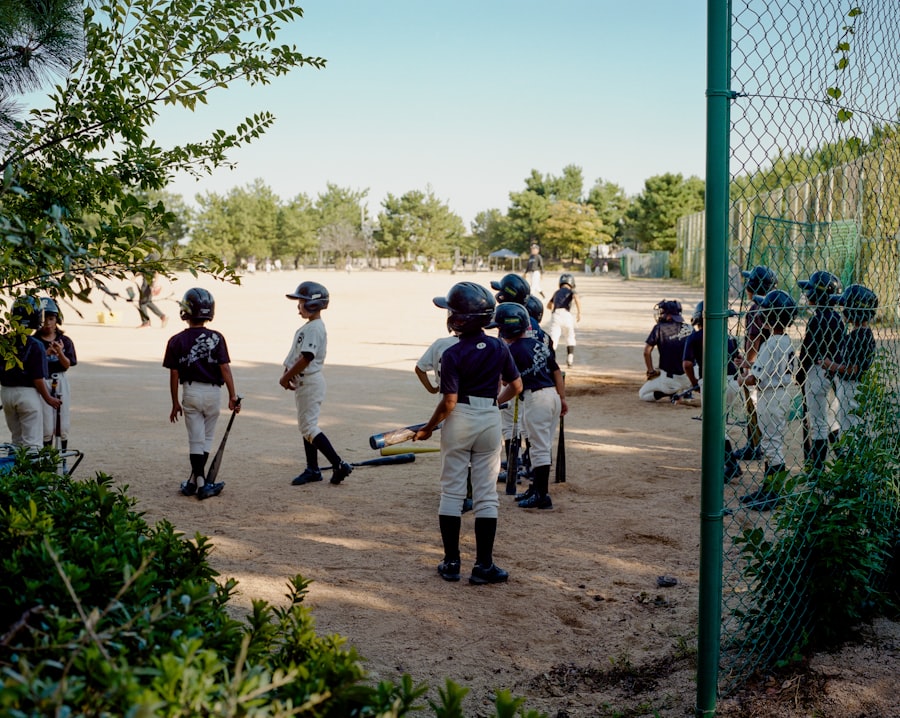Download links
How to install Mastering the Art of Softball: Tips for Success APK?
1. Tap the downloaded Mastering the Art of Softball: Tips for Success APK file.
2. Touch install.
3. Follow the steps on the screen.
Description
Softball, a sport that has gained immense popularity across various age groups and skill levels, is characterized by its unique rules and gameplay that distinguish it from baseball. The game is played on a diamond-shaped field with four bases, and the objective is to score runs by hitting a pitched ball and running around the bases. The standard softball field is larger than a baseball field, with the distance between bases typically set at 60 feet.
The pitching distance varies depending on the level of play, with fast-pitch softball requiring pitchers to throw from 43 feet away from home plate, while slow-pitch softball has a pitching distance of 50 feet. The game is played between two teams, each consisting of nine to ten players, depending on the format. The fundamental rules of softball include three outs per half-inning, with teams alternating between batting and fielding.
Batters aim to hit the ball and reach base safely, while fielders strive to catch the ball and prevent runs from scoring. Understanding these basic elements is crucial for anyone looking to engage in the sport, as they form the foundation upon which more advanced skills and strategies are built. Additionally, the equipment used in softball, such as gloves, bats, and balls, is specifically designed to enhance performance and ensure safety during play.
Key Takeaways
- Softball is a team sport similar to baseball, with a few key differences in rules and equipment.
- Proper hitting, fielding, and pitching techniques are essential for success in softball and require dedicated practice and coaching.
- Physical conditioning and strength training are crucial for improving performance and preventing injuries in softball.
- Mental toughness and focus are important for staying calm under pressure and making quick decisions on the field.
- Teamwork and communication skills are vital for success in softball, as the game requires coordination and cooperation among players.
Developing Proper Techniques for Hitting, Fielding, and Pitching
Mastering the fundamental techniques of hitting, fielding, and pitching is essential for any aspiring softball player. Hitting requires a combination of timing, hand-eye coordination, and body mechanics. A proper batting stance involves positioning the feet shoulder-width apart, knees slightly bent, and weight distributed evenly.
As the pitcher delivers the ball, players must focus on tracking its trajectory while maintaining a balanced stance. The swing should be a fluid motion initiated by the hips, followed by the shoulders and arms, culminating in a powerful follow-through. Practicing drills that emphasize these components can significantly enhance a player’s hitting ability.
Fielding techniques are equally important in softball. Players must develop skills in catching, throwing, and positioning themselves effectively on the field. A fundamental aspect of fielding is the “ready position,” where players stand with their knees bent and glove outstretched, prepared to react quickly to a hit ball.
Ground balls require players to approach the ball with their glove low to the ground while using their body to block it if necessary. For fly balls, players must judge the ball’s trajectory and position themselves accordingly to make an effective catch. Throwing accuracy is vital; thus, practicing proper grip and arm motion can lead to improved performance in both infield and outfield positions.
Pitching is often regarded as one of the most challenging aspects of softball. Fast-pitch pitchers must master various pitches such as fastballs, change-ups, and curveballs. The windmill motion used in fast-pitch requires precise mechanics to generate speed and spin on the ball.
A strong foundation in grip and release point is crucial for achieving accuracy and movement on pitches. Additionally, pitchers must develop mental acuity to read batters and adjust their strategy accordingly. Regular practice sessions focusing on pitch variety and control can help pitchers refine their skills and become more effective on the mound.
Improving Physical Conditioning and Strength

Physical conditioning plays a pivotal role in a softball player’s overall performance. The demands of the game require athletes to possess a combination of speed, agility, endurance, and strength. A well-rounded conditioning program should include cardiovascular exercises such as running or cycling to build endurance, as well as strength training to enhance muscle power.
Exercises targeting core strength are particularly beneficial for improving stability during batting and pitching. Agility drills are essential for developing quick footwork and reaction times on the field. Ladder drills, cone sprints, and shuttle runs can help players improve their lateral movement and overall speed.
Additionally, flexibility training through stretching or yoga can prevent injuries and enhance range of motion, allowing players to perform at their best during games. Incorporating these elements into a regular training regimen will not only improve individual performance but also contribute to overall team success. Nutrition also plays a critical role in physical conditioning.
A balanced diet rich in carbohydrates, proteins, healthy fats, vitamins, and minerals provides the necessary fuel for athletes during training and competition. Hydration is equally important; players should ensure they are adequately hydrated before, during, and after games to maintain peak performance levels. Understanding how nutrition impacts energy levels can empower players to make informed choices that support their athletic goals.
Mastering Mental Toughness and Focus
| Metrics | Results |
|---|---|
| Number of training sessions | 20 |
| Success rate in overcoming challenges | 85% |
| Improvement in focus | 30% |
| Reduction in stress levels | 40% |
Mental toughness is an often-overlooked aspect of athletic performance that can significantly influence a player’s success on the field. The ability to remain focused under pressure, maintain composure after mistakes, and stay motivated throughout a long season is crucial for achieving peak performance. Developing mental resilience involves cultivating a positive mindset that embraces challenges as opportunities for growth rather than obstacles.
Visualization techniques can be an effective tool for enhancing mental focus. Players can practice visualizing themselves successfully executing specific skills or strategies during games. This mental rehearsal helps build confidence and prepares athletes for real-game scenarios.
Additionally, mindfulness practices such as meditation or breathing exercises can help players manage anxiety and maintain concentration during high-stakes moments. Setting realistic goals is another important aspect of developing mental toughness. By establishing short-term objectives that align with long-term aspirations, players can create a roadmap for their development while maintaining motivation throughout their journey.
Celebrating small victories along the way reinforces positive behavior and encourages continued effort toward improvement.
Enhancing Teamwork and Communication Skills
Softball is inherently a team sport that relies heavily on effective communication and collaboration among players. Building strong teamwork skills begins with fostering trust and camaraderie within the team. Regular team-building activities can help players develop relationships off the field that translate into better communication during games.
On-field communication is vital for coordinating plays and ensuring everyone is aware of their responsibilities. Players should practice calling for balls in the outfield or communicating signals for defensive strategies. Establishing clear roles within the team can also enhance efficiency; knowing who is responsible for specific plays reduces confusion during critical moments.
Moreover, active listening is an essential component of effective communication. Players must be receptive to feedback from coaches and teammates alike to foster an environment of continuous improvement. Encouraging open dialogue allows players to express concerns or suggestions freely, ultimately leading to a more cohesive team dynamic.
Utilizing Strategy and Game Tactics

Understanding game strategy is crucial for maximizing performance in softball. Coaches often develop specific tactics based on their team’s strengths and weaknesses as well as those of their opponents. Familiarizing oneself with various offensive strategies—such as bunting or stealing bases—can provide teams with an edge during games.
Defensive strategies are equally important; teams must be prepared to adapt their formations based on the opposing team’s batting lineup or game situation. For instance, employing a shift defense against a pull hitter can increase the likelihood of making outs. Players should also be aware of situational tactics; knowing when to execute a double play or when to hold a runner at third base can significantly impact game outcomes.
Analyzing game footage can provide valuable insights into both individual performance and team dynamics. Coaches often review past games with players to identify areas for improvement or successful strategies that can be replicated in future matchups.
Learning from Mistakes and Seeking Continuous Improvement
Mistakes are an inevitable part of any sport, including softball; however, how players respond to these setbacks can define their growth as athletes. Embracing mistakes as learning opportunities rather than failures fosters resilience and encourages continuous improvement. Players should reflect on their performances after games or practices to identify areas where they can enhance their skills or decision-making.
Constructive feedback from coaches and teammates plays a vital role in this process. Engaging in open discussions about what went wrong during specific plays allows players to gain different perspectives on their performance. This collaborative approach not only promotes individual growth but also strengthens team dynamics as players work together toward common goals.
Setting aside time for self-assessment can also be beneficial; players might keep journals detailing their experiences during practices or games. This reflective practice encourages athletes to track their progress over time while identifying patterns in their performance that may require attention.
Nurturing a Passion for the Game and Enjoying the Journey
Ultimately, nurturing a passion for softball is essential for sustaining long-term engagement with the sport. Players who genuinely enjoy what they do are more likely to invest time in practice and development while remaining committed through challenges. Finding joy in both individual achievements and team successes fosters a positive atmosphere that enhances overall enjoyment of the game.
Encouraging players to explore different aspects of softball—such as coaching younger athletes or volunteering at local leagues—can deepen their appreciation for the sport while giving back to the community. Engaging with fellow enthusiasts through camps or clinics allows players to connect with others who share their passion while learning new skills. Moreover, celebrating milestones—whether personal achievements or team victories—can reinforce love for the game.
Recognizing hard work through awards or simple acknowledgments fosters motivation among players while creating lasting memories that contribute to their overall experience in softball. In conclusion, embracing every facet of softball—from mastering techniques to fostering teamwork—enriches not only individual performance but also enhances collective success on the field. By focusing on continuous improvement while nurturing a genuine passion for the game itself, athletes can embark on an enjoyable journey filled with growth opportunities both as players and individuals.
FAQs
What is softball?
Softball is a bat-and-ball sport similar to baseball, played on a smaller field with a larger ball. It is typically played by two teams of 9 players each.
What are the basic rules of softball?
The basic rules of softball include pitching the ball underhand, hitting the ball with a bat, and running around the bases to score runs. The game is typically played over 7 innings, with each team taking turns at bat and in the field.
What equipment is used in softball?
Softball players use a glove, bat, helmet, and cleats. The ball used in softball is larger and softer than a baseball.
What are the different positions in softball?
The positions in softball include pitcher, catcher, first baseman, second baseman, third baseman, shortstop, and outfielders (left field, center field, and right field).
What are the different types of softball games?
There are different types of softball games, including fastpitch and slowpitch. Fastpitch softball is played at a higher speed with a larger emphasis on pitching and fielding, while slowpitch softball is played at a slower pace with a larger emphasis on hitting.





